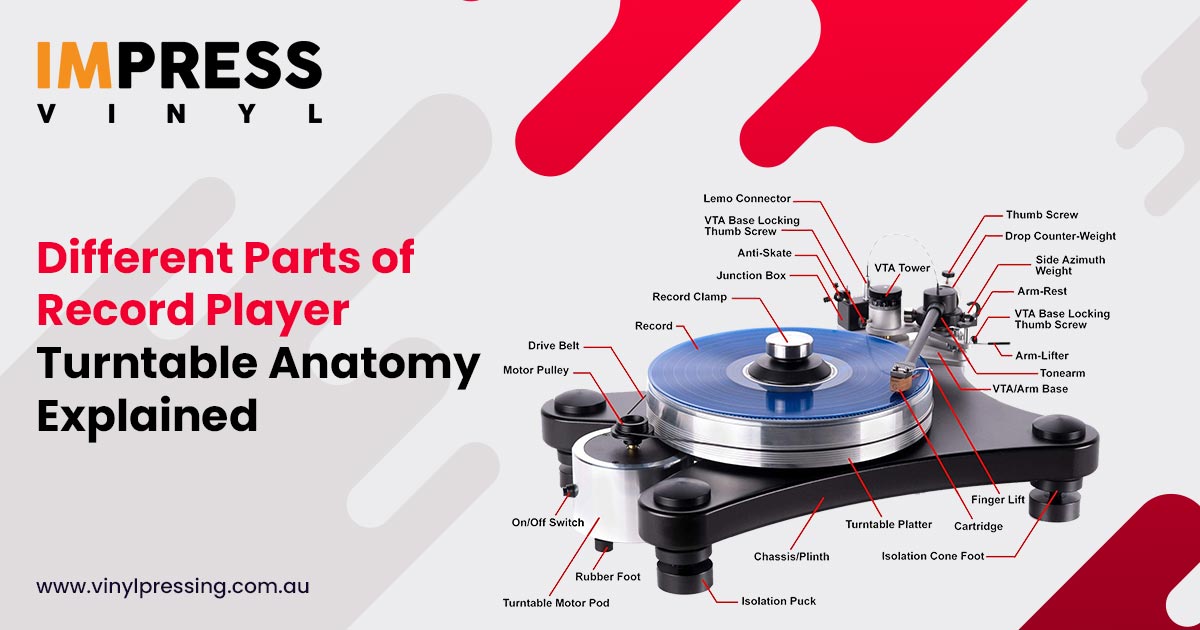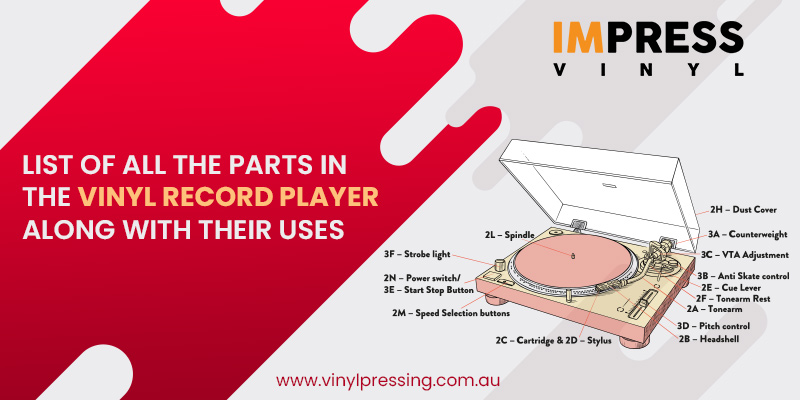Different Parts of Record Player | Turntable Anatomy Explained

The vinyl record player is both vintage and classy and always holds a special place in the vintage hearts of music lovers. But have ever wondered how this antique record player works like a new one till now? Or ever thought about the different parts of the vinyl record player and how it’s all connected?
A turntable is a device that rotates records at an even pace and is usually used to play vinyl records. The electrical signal produced by the stylus is amplified by an amplifier, and the amplified signal is played through a loudspeaker that is linked to the turntable.
In this blog, we have explained everything you need to know about the vinyl record player anatomy.
Decoding Vinyl Magic with the Anatomy of Vinyl Record Player
You might be surprised by the number of parts a vinyl record player has. It’s not just the outer parts, let’s include all the parts.
List of all the parts in the vinyl record player along with their uses:
Tonearm
The cartridge and stylus are held in place by the tonearm, a rotating arm of a turntable. It moves across the grooves of the record, transmitting analog signals to the amplifier. It is essential for the right playback and maintaining record longevity since it can be adjusted for tracking force and anti-skate.
Cartridge
The stylus is enclosed in the cartridge, which is an essential part of a turntable. The stylus tracks the record grooves, converting the mechanical vibrations into electrical signals that are amplified and converted into audible sound by audio equipment.
Plinth
The plinth is the base of a turntable, providing structural support and stability. It often incorporates isolation features to minimize vibrations and interference. This foundation helps maintain the accuracy of the stylus tracking the record grooves for optimal audio playback quality.
Headshell
As the part that connects the tonearm and cartridge in a turntable, the headshell is crucial. Adjustments and alignments are possible, ensuring that the stylus is precisely positioned on the record grooves for precise tracking and excellent audio reproduction.
Stylus
The stylus is the needle part of a cartridge used in turntables. Through the careful tracing of vinyl record grooves, it turns mechanical vibrations into electrical signals. Its design has an impact on musical quality and tracking precision making it an essential component in analog sound reproduction.
Pre-amplifier
An electrical device called a preamplifier, or preamp is used to equalize and boost weak audio signals from sources such as guitars, turntables, and microphones before sending them to an amplifier. It ensures the strongest possible signal, minimizes interference and gets the music ready for more amplification in the main amplifier or receiver.

Speed Selector
A turntable’s speed option lets users adjust how quickly the platter rotates. 33⅓, 45, and 78 RPM (revolutions per minute) are common choices. This function ensures interoperability with several vinyl record types, each of which is meant to be played at a specific tempo. Maintaining correct pitch and playback quality in accordance with the vinyl recording criteria requires precise speed selection.
Belt
The belt in a turntable is a flexible loop that connects the platter and motor. It is an element of belt-drive turntables that facilitates steady and smooth rotation by transferring rotational energy from the motor to the platter. For better audio playing, this design lessens motor vibrations and the motor noise that is transferred to the stylus.
Speakers
Electrical signals are transformed into audible sounds by speakers. They are made up of drivers that are enclosed, like tweeters and woofers. Speakers generate audio frequencies for listening pleasure when powered.
Direct Drive Motor
A turntable’s direct-drive motor is located directly underneath the platter, eliminating the need for a belt. This design reduces wow and flutter by providing accurate and steady rotation. As a result of its steady speed control and quick startup, it’s the favored choice for DJs.
Cueing Liver
A turntable’s cueing lever allows you to manually control the tonearm’s descent onto a vinyl record. It facilitates delicate installation and retrieval by enabling accurate tonearm positioning and lifting. This function is used by DJs and audiophiles to control the playback process to avoid damage to records.
Platter
The vinyl record is placed on the platter, which is the turntable’s rotating surface. The motor drives it at a preset tempo, enabling the stylus to follow the grooves of the record for audio playback.
RCA Output
An RCA cable can be used to connect a turntable’s RCA output to audio equipment such as amplifiers or receivers. Through the transfer of the analog signal from the turntable’s cartridge, external speakers can be used to amplify and reproduce the music.
Final Thoughts on the Vinyl Record Anatomy
A vinyl record player’s anatomy has a complicated web of interconnected parts. Every component enhances the analog experience, from the plinth’s durability to the stylus’s precise tracing of grooves. Gaining an understanding of the tedious process required to play and enjoy vinyl records is enhanced by knowing this anatomy.
Looks like you have a lot to keep in mind but fret not; Impress Vinyl can make your work easier because we are the experts in vinyl record pressing and we offer the finest custom vinyl record in Australia. So don’t worry you’re in safe hands.
Visit Impress Vinyl’s website to learn more about custom vinyl record pressing and how to maintain it and retain the vintage vibe with Impress Vinyl!
